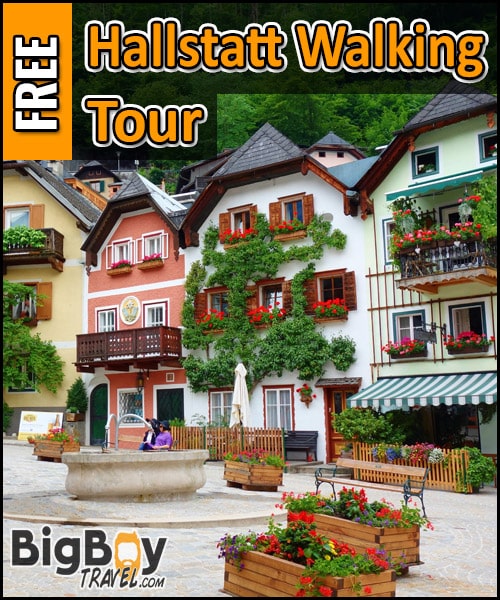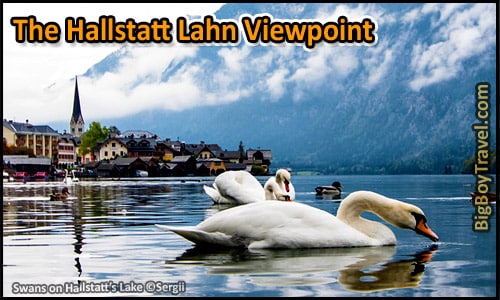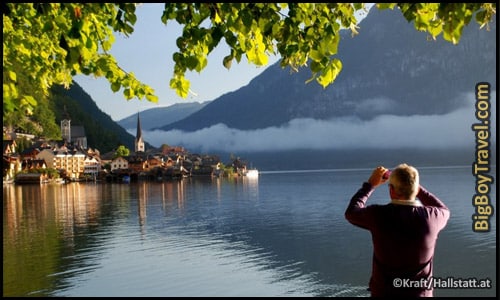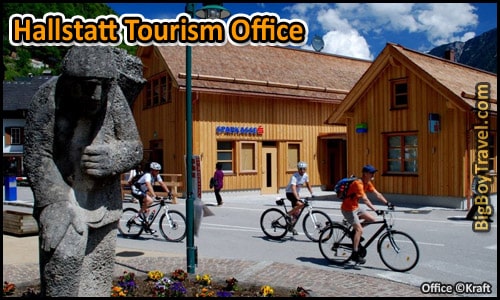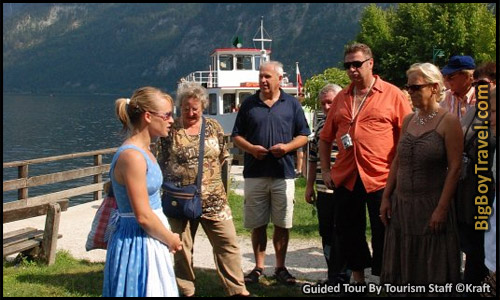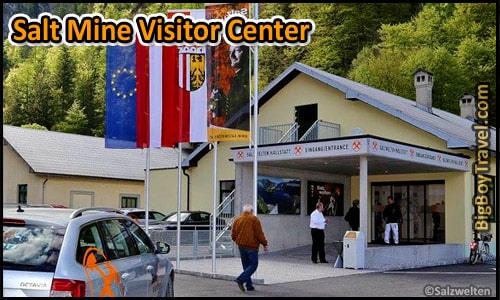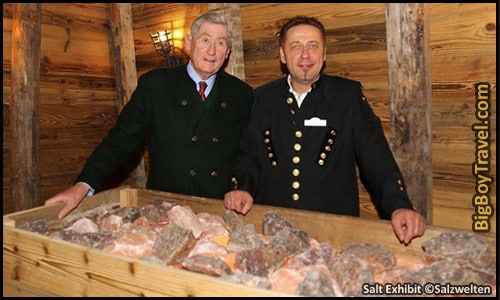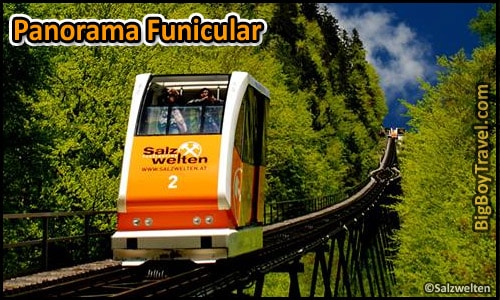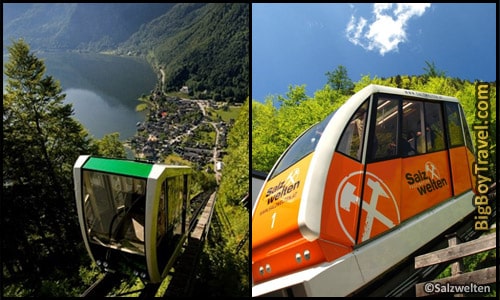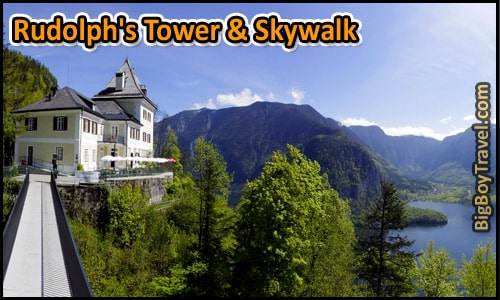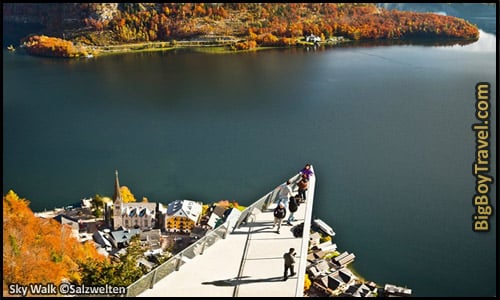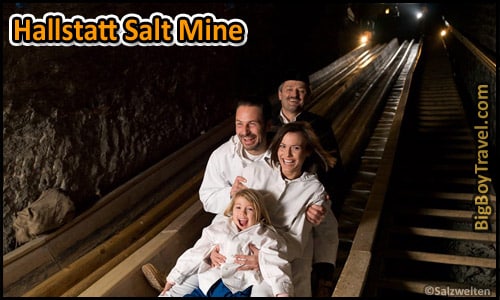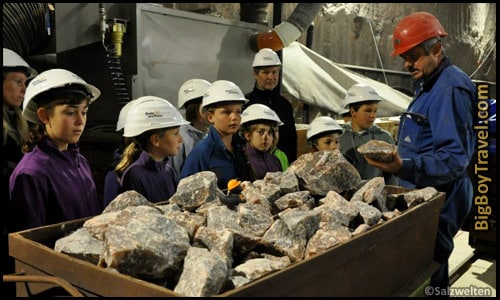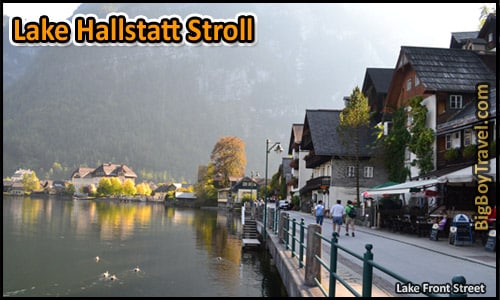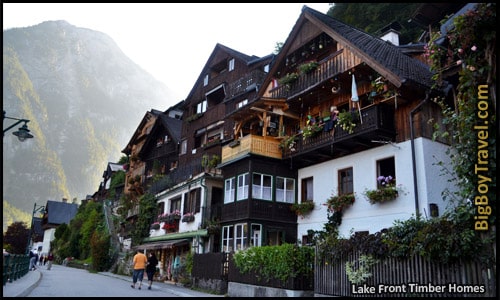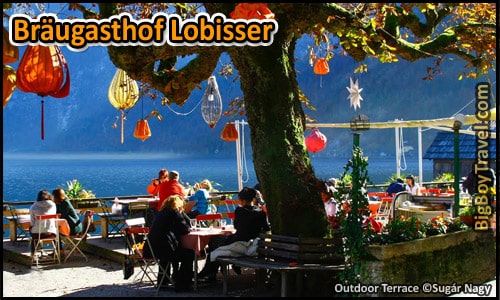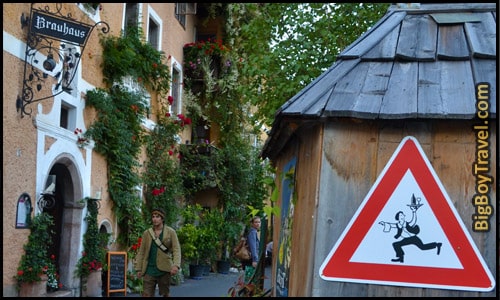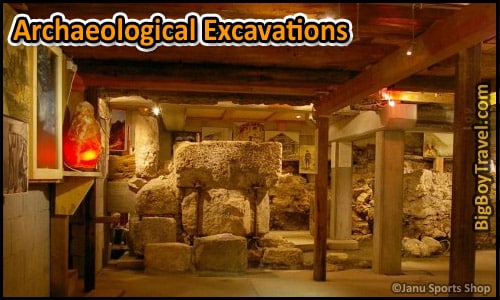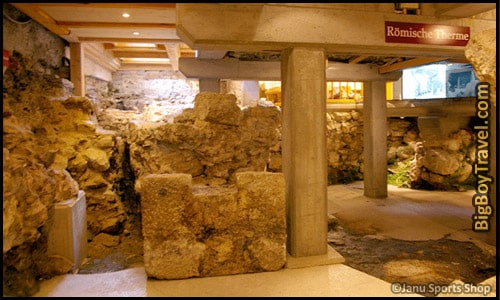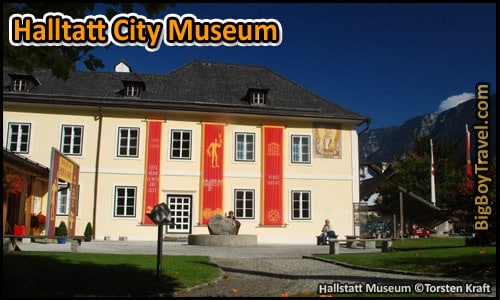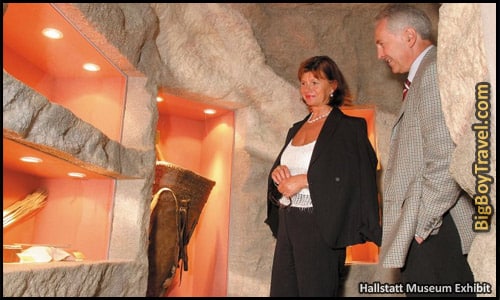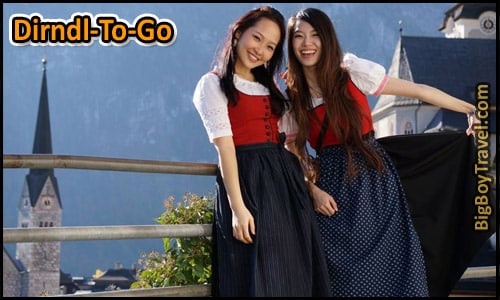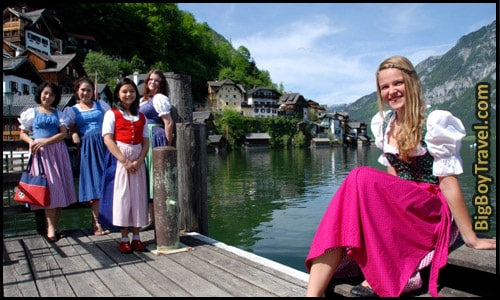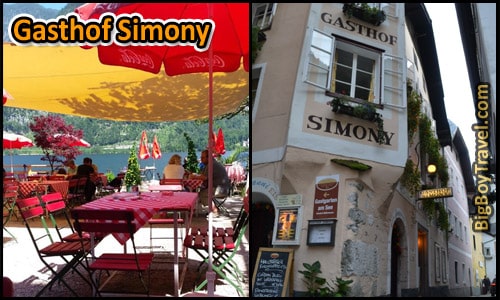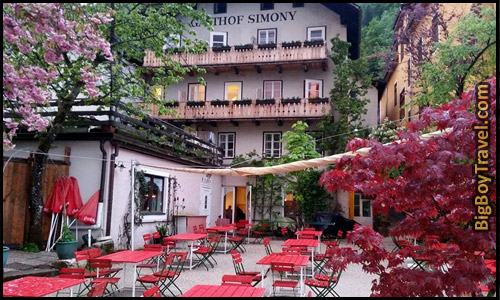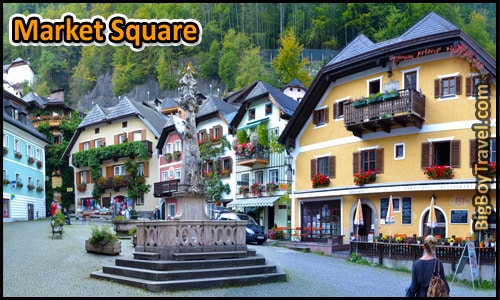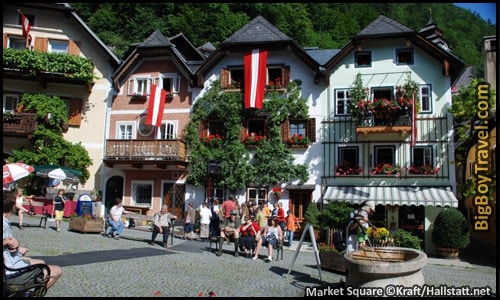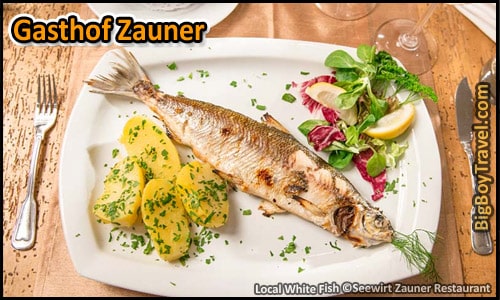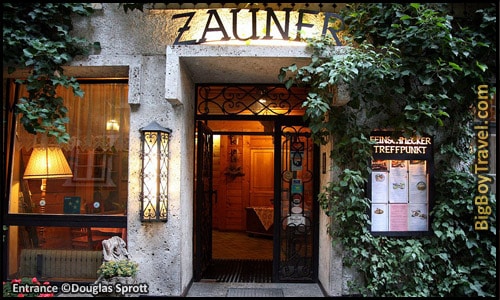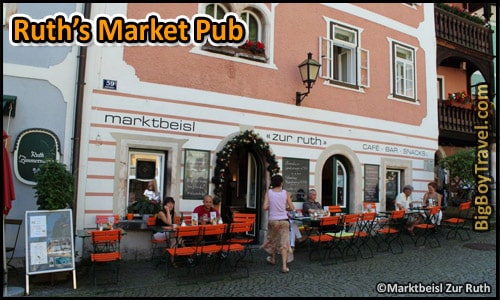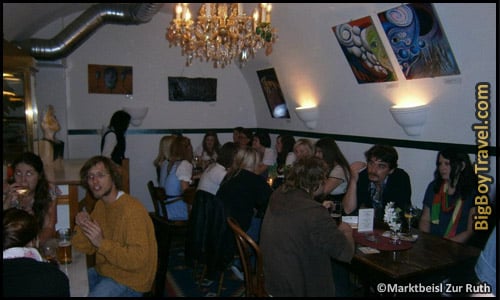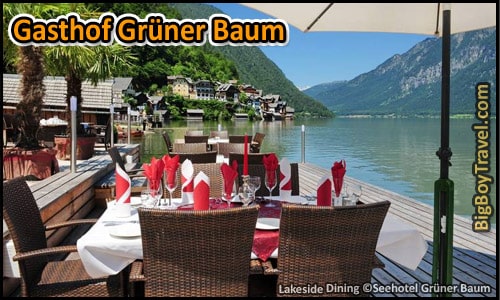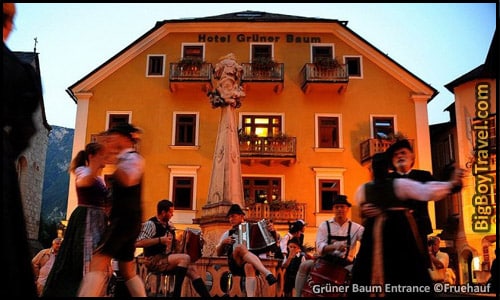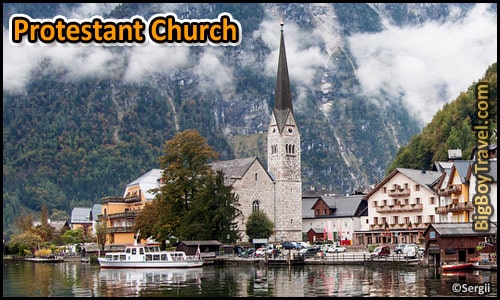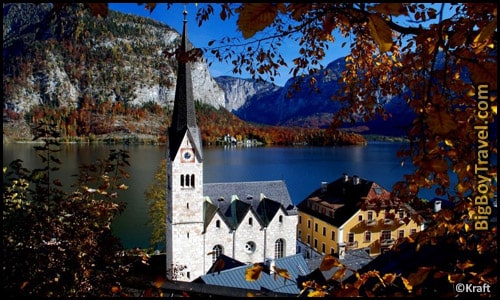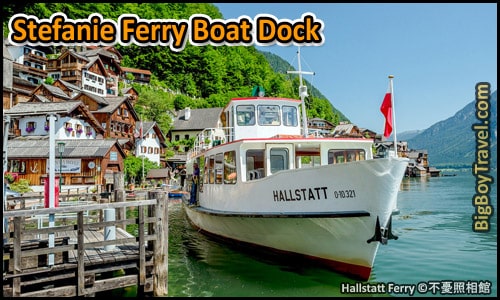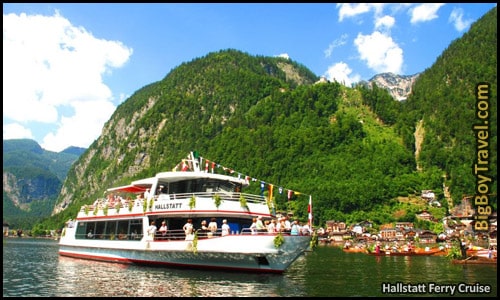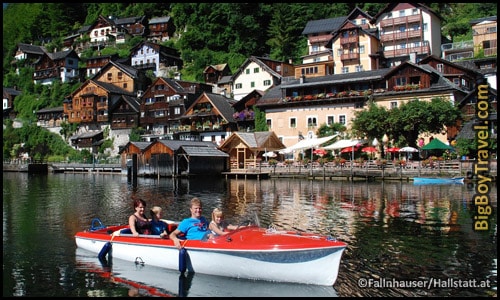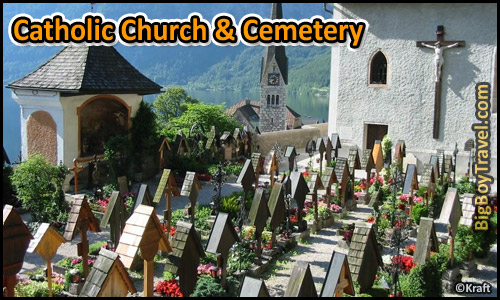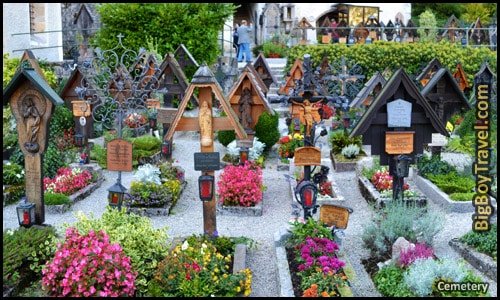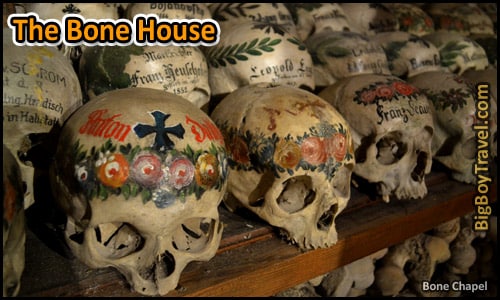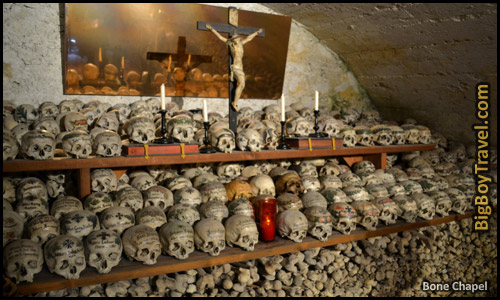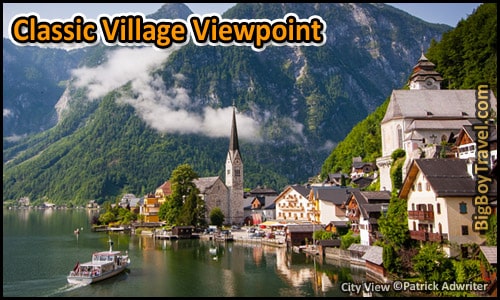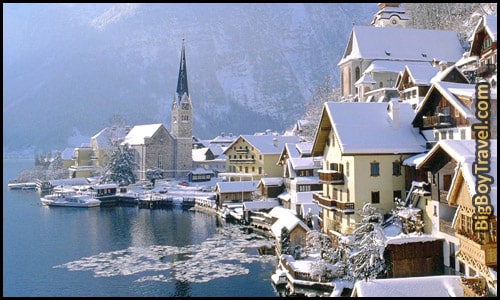Free Hallstatt Walking Tour:
Location: Old Town Hallstatt, Austria
Cost: Free, Self-Guided (Salt Mine, Boat, & Bone Chapel costs below)
Style: Do-It-Yourself Walking Tour (Self Guided)
Start: City View Point Near Hallstatt’s Bus Stop
End: City View Point Past Stefanie Boat Dock
Distance: 1 mile of walking
Walking Time: 2 hours (+3 hours for Salt Mine tour & +1 for a boat rental)
Fun Scale: 10 out of 10
Hallstatt Overview:
There was a Hallstatt before there was a Rome, and you’ll love every minute you spend strolling through this quaint 7,000-year-old Alpine village! This self-guided Hallstatt walking tour can easily be completed in half a day giving you plenty of time to check out the Ice Caves, full salt mine tour, or take a paddle boat on the lake. If you arrive in Hallstatt by train and ferry boat instead of the bus, consider doing this self-guided walking tour of Hallstatt in reverse order. We hope you enjoy our free Hallstatt walking tour map!
Free Hallstatt Walking Tour:
1. Hallstatt Lahn Viewpoint:
About The Hallstatt Lahn Viewpoint: Located on the Southern edge of Old Town Hallstatt, the village’s main bus stop (Hallstatt Lahn) is the perfect place to start our free Hallstatt walking tour. If you followed our How To Get To Hallstatt guide, then you would arrive at Hallstatt Lahn as the bus is faster and cheaper than the train option. You’ll immediately be struck with amazing panoramic views of Hallstatt clinging to the lake with a glorious Alpine backdrop. Make sure to take a while to relax by the water and appreciate the scenery.
On most days the Lahn area is a great spot to get up close and personal with the swans of Hallstatt. The swans were imported here during the 1860s when Austrian Emperor Franz Josef and Empress Sisi started to visit on annual retreats. Sisi, like her cousin Mad King Ludwig of Bavaria, had a borderline obsession with swans. Ludwig even named his most famous castle Neuschwanstein (New Stone Swan Castle), which is our favorite castle in Europe, after his beloved birds.
The Hallstatt Lahn bus stop is also a very important location to know if you plan on taking the bus to any of the surrounding towns or the Dachstein Ice Caves. From here Bus 543 continues on to the Ice Cave Visitor Center in just a 10-minute ride and you can also ride North for connections to hike in places like Gosausee.
2. Hallstatt Tourism Office:
About The Tourism Office: The Tourism Office in Hallstatt is a great place to pick up free brochures and to find info on upcoming town events. Outside of general information, the Tourism Office can answer your questions and they even have a limited number of guided tours available throughout the year. Most visitors who stop by the building are here more for the public bathrooms than the brochures.
Guided Tours: 4 Euro guided city tours are available in English on Saturdays in the Summer. Luggage Storage: The office used to have luggage storage but no longer does as of 2018, if you need this service please see our Luggage Storage in Hallstatt page. Visitor Center Hours: January-April Monday-Friday 8:30am-5pm, Saturday 9am-1pm, Sundays Closed. May & June Monday-Friday 8:30am-5pm, Saturday & Sunday 9am-2:30pm. July-October Monday-Friday 8:30am-6pm, Saturday & Sunday 9am-4pm. November & December Monday-Friday 8:30am-5pm, Saturday & Sunday Closed.
3. Salt Mine Visitor Center:
About The Salt Mine Visitor Center: Opened in 2016, the visitor center at the base of Salt Mountain is a great place to get a peek at the tours of the Salt Mine. You can see displays with raw salt rock and can buy tickets for either the Salt Mine Tour or just the funicular lift by itself to visit the Skywalk Lookout. The bag lockers at the Salt Mine Visitor Center are also one of the only places in central Hallstatt where you can store your luggage while visiting the town. There is also some bag storage at the Dachstein Ice Cave Visitor Center with more info on our Luggage Storage in Hallstatt page.
Hours: Open daily early February-March 9am-5:30pm; April-September 9am-7pm; October-early January 9am-5:30pm; CLOSED early January-early February.
Read More: Salt Mine Tour Attractions
4. Panorama Funicular (Salzbergbahn):
About The Panorama Funicular: If you want an amazing view of Hallstatt, the lake, and the surrounding Alps, the glass-walled Salt Mine Funicular is definitely for you. It only takes 3 minutes to climb 1181 feet up the mountainside and the views just keep getting better and better on the way up. Even if you don’t have time for a 2-hour tour of the salt mines (stop #6), the funicular is more than worth the ride! Alternative you can hike up the hike hill in about an hour from the center of Hallstatt on either the Salt Brine of Panorama trails, but the funicular works best for most visitors schedule-wise.
Time Required: Expect around 45-60 minutes roundtrip to take the funicular up to see the skywalk and take in the views. Add 2 hours if you wish to do the full salt mine tour.
Hours: Open daily early February-March 9am-4:30pm; April-September 9am-6pm; October-early January 9am-4:30pm; CLOSED early January-early February. (Current Schedule). Cost: Funicular costs 18€ round trip for Adults or 10€ one way; children 50% off; family passes available. Combo rates available if attending the salt mines.
Read More: Salt Mine Tour Attractions
5. Rudolph’s Tower & Skywalk (Rudolfsturm):
About Rudolph’s Tower & Skywalk: Rudolf’s Tower and Restaurant greets all Salt Mine visitors directly at the top of the funicular route. Walking to the tower is tons of fun as you get to cross the Lookout Bridge spanning a small gorge sitting hundreds of feet below you. From Rudolf’s large patio hanging 1148 feet above Hallstatt, you’ll experience unmatched open-air views of the lake, village, and the surrounding Alpine mountains.
The tower, built in 1282, was constructed by Duke Albrecht I of Austria as a defense for the mine workers on the Salzberg (Salt Mountain). He named the tower after his father Afder Rudolf I, the first leader of the Hapsburg empire. In 1313 the tower became the residence of the mine manager and remained so for more than 640 years. During this time many famous people of the day visited the tower such as Emperor Maximilian. Johann Georg Ramsauer, the discoverer of the Hallstatt cemetery in 1833, renovated the tower and expanded the grounds after a fire claimed much of the area in the 1800s. The current restaurant wasn’t opened until 1960.
Time Required: Expect around 45-60 minutes roundtrip to take the funicular up to see the skywalk and take in the views. Add 2 hours if you wish to do the full salt mine tour.
Getting To Rudolf’s Tower: You can either do a strenuous 1-hour hike up from the center of Hallstatt or the easy option is to take the funicular. Hours: Open depending on the weather February & March; daily April through July 15th from 9am-6pm; July 16th through November from 9am-4:30pm; and CLOSED Early-December until February. Cost: Funicular costs 12€ for Adults, children 50% off, family passes available. Combo rates available if attending the salt mines.
Read More: Salt Mine Tour Attractions
6. Hallstatt Salt Mine (Salzwelten):
About The Hallstatt Salt Mine: You would think that the discovery of concrete in the mine from 1,500 BC would make this an old salt mine, but it’s actually much older. In 1838, workers found a pick made of staghorn from the Neolithic Age dating back to 5,000 BC, making the mine 7,000 years old!! This makes Salzwelten the oldest salt mine in Europe and one of the oldest in the world!
During the 1800s there was even more of a big time for discoveries at the mine, like in 1833 when the mining director found the Hallstatt miners’ burial grounds. In total, almost 2,000 burials have been found on the hilltop from the Neolithic and Bronze Ages. These discoveries, along with other comprehensive finds from the early Iron Age, and evidence of Hallstatt’s early influence across Europe, have led historians to call the period between 800-400BC the Hallstatt Era.
Today visitors to the mine are given a very wide range of activities from a ride on a barge over the mine’s salt lake, a slide down the old wooden miners’ shoot, interaction with large salt blocks, and the Man in Salt which is our favorite thing. The Man in Salt was discovered in 1734 when the body of a former miner was found, perfectly preserved in salt. Records describe the corpse as being pressed flat as a board and features worn away by stone. Clothing and tools quite unusual, but completely intact.
Time Required: While the underground portion is 50 minutes long your visit including walking to the mine and getting dressed in your miners’ clothes will require 2 hours of time for the tour. The average total visit with the funicular ride is 2.5-3 hours, but even if you can commit that much the funicular ride for the Skywalk Lookout views are well worth it.
Tours: Two hour-long tours run Daily the first week of March through late-September departing from 9:30am-4:30pm; mid-September through October from 9:30am-3pm; November through early-December from 9:30am-2pm; and are CLOSED early-December until March. Cost: our by itself is 24€ for Adults or 34€ for a tour with round-trip funicular ride; children 50% off; family passes available.
Read More: Salt Mine Tour Attractions
7. Lake Hallstatt Stroll:
About The Lake Hallstatt Stroll: After descending the Funicular, you’re quickly given your first taste of Hallstatt’s true beauty, the tightly stacked timber homes! For us, this lakeside stroll is one of the more delightful parts of our free Hallstatt walking tour. As you walk along the edge of Lake Hallstatt, notice how village’s houses cling to the cliffside of the Salt Mountains (Salzberg) overlooking the lake. The houses were built stacked like this not only because of a lack of land but also so more residents could have direct lake access.
When many of the homes in Hallstatt were first built, street-level you see today was the 1st floor (2nd for Americans), but the ground floors were at water level and were mainly used as boat garages for lake access. Thanks to a dam built in 1511, the water level was raised in the lake making boating even easier for the residents. Until the late 1800s, the only way to reach the houses was either by boat or through the narrow pathways like the one still visible just over the roofs of the cliffside houses today.
In 1890, the road you are walking on was built, making the village greatly more accessible although part of the local lakeshore needed to be blasted away to make the road’s path. If you walk down any of the lakeside steps and peek under the road you can see that it is actually elevated on stilts above the water in most parts on this section of our free Hallstatt walking tour.
A good way to visually determine how old each house in Hallstatt is to see how much of it is built completely out of timber versus stone. Ones with more stone features have either been rebuilt after fires or renovated over the years while the ones that are almost completely timber are more likely to be untouched over the centuries.
8. Bräugasthof Restaurant & Guesthouse:
About Bräugasthof: Bräugasthof’s guesthouse, first documented in 1472, originally served as a salt manufacturing center where salt brine from the mine up the hill was turned into pure salt. The building has an excellent lake level cellar which provided storage and easy water access to the local boats who could transport the finished product to other cities. The upper levels of the building served as a guesthouse which it still does today. In 1504, Emperor Maximilian gave the property owners the right to brew and serve beer.
The family’s beer business quickly grew well known as the Market Brewery with excellent, strong brews that were served in large mugs. Market Brewery stuck as the name for over 400 years before it was changed to Bräugasthof. Today the restaurant has a great patio right on the lake and a spectacular breakfast buffet. The 8 room hotel attached to the beer hall is open all year round and has charming, romantic rooms with traditional Austrian furniture and balconies with a view to the Lake.
Outdoor Seating: The lakeside dining is only available Spring-late Fall and during the Winter their main restaurant is across the street inside the hotel. Website: Here.
9. Ancient Archaeological Excavations:
About Hallstatt’s Archaeological Excavations: There was a Hallstatt before there was a Rome, and the best place to get a peek at how old Hallstatt really is are the impressive archaeological excavations below Juno Sports Shop. Discovered in 1990, excavations have uncovered structures and artifacts from the Middle Ages all the way back to the Stone Age. There are excellent paving stones from 3 eras including early Hallstatt (pre-Roman), Roman building foundation sections, and the outer walls of the Habsburg residence from early Medieval Times. We love the salt mine forges on exhibit which has numerous metal tools and a hammer mill. There is also a wide range of ceramics from the Stone Age, pre-historic era, Roman times, and the Middle Ages.
Cost: Free Hours: Daily in summer 9am-6pm; closed on Sundays in Winter. Website: Here.
10. Hallstatt City Museum (Stadtmuseum):
About Hallstatt’s City Museum: Although there have been people mining salt and living in the Hallstatt area since 5,000 BC, the village didn’t really start gaining power until between 800-400 BC (The Hallstatt Era) when they started exporting theirs. This museum, founded in 2002, covers the entire 7,000 year period but mainly focuses on the Hallstatt Era. The Museum has been completely restored and refurbished recently with very modern facilities for visitors. This contemporary museum provides wonderful insight into the unique history of Hallstatt and the surrounding area. The City Museum is an excellent indoor option if it starts to rain while you are following our free Hallstatt walking tour.
Time Required: It took us about 1 hour to get our fill at the City Museum. It is a very informative place but is best visited if you are in town for 2-3 days than on a single day visit unless it is after dinner on an overnight stay in the Summer during extended hours.
Hours: November–March: Wednesday to Sunday 11am-3pm, July & August it stays open later until 8pm. Cost: Adults €7.50, family passes available. Guided Walking Tour: Each Saturday July-October the Museum offers guided walking, check at the office for times. Candlelit Boat Rides: Starting late each July through late August, candlelit boat rides leave the Hallstatt Markt boat pier at 8:30pm on Thursday evenings €13.50 or €16 combo-ticket with the Hallstatt Museum. Website: Here.
11. Dirndl-To-Go Rentals:
About Dirndl-To-Go: Dirndl-To-Go will help you enhance your photos with rentals of traditional Alpine clothing while you follow our free Hallstatt walking tour. One of the most popular options for female visitors a tight-fitting Bavarian dirndl (DEERN-dul) dress with an apron tied around it so you can feel like you are in The Sound of Music. As they often get busy, we recommend reserving your Dirndl ahead of time to make sure you are able to get one. Remember that in peak Summer season Hallstatt can get as many as 50 tour buses, so you want to be ahead of the curve if you want a rental.
Hours: Open daily May-middle if October 11am-5pm for walk-ins; appointments suggested on weekends. Reservations: dirndl-to-go@hallstatt.net. Cost: 1st hour €22; Each extra hour €6; Half-Day €35; Full-Day €50 (Group discounts available). Address: Wolfengasse 105 (connected to Gasthof Simony). Website: Here.
12. Gasthof Simony:
About Gasthof Simony: The narrow alleyway leading past Gasthof to Market Square is one of our favorite places to take photos on this free Hallstatt walking tour. You’ll notice how the alley’s buildings are mainly bright multicolored stone instead of the dark timber-framed buildings you’ve seen so far. This is due largely to the Fire of 1750 that partially burned half of Hallstatt. The more stone a building in this area of town is, the further it was damaged by the Fire of 1750. It’s amazing how taxis and vans are able to wiz through the tightness of the alley. The narrowness leads to perfect contrasting of light on the surfaces of the multicolored buildings.
The first of the tightly packed buildings you’ll come to is the mustard colored Post Office, followed by a bright pink building, and finally, the peach-colored Gasthof Simony. First mentioned in a document in the 15th century, the house was used as a theater for the salt-producing family Wolfen. The alleyway along the home is still named Wolfengasse after the family. When the Wolfens left the salt trading business their house became a restaurant.
The first and the second floor of the Simony house were badly hurt by the fire of 1750, however, the vaults of the ground floor were fortunately not damaged. In 1882, the Klackl family bought the building and renovated the house into a hotel. Famous explorer of the Dachstein region Friedrich Simony was a regular guest in the hotel and the name was later changed into Gasthof Simony after him. Guests who stay at Gasthof Simony are happy to know that the guest house offers the use of their lake canoes free of charge.
Website: Here.
13. Market Square (Marktplatz):
About Market Square: While the Hallstatt Museum focuses on the early days and ancient Hallstatt Era, Market Square is a testament to Hallstatt’s true glory days in the Middle Ages. Instead of only exporting salt, the village became a true trading hub when it was granted market rights in 1311. This new status led to a wealthy building boom centered on the newly formed Market Square which lasted until the Salt Administration was banned in 1850.
The massive decorative statue in the center of the romantic square represents the Holy Trinity. It was donated by the Imperial Salt Master (maybe just a merchant???), Johann Ignaz Etzinger, in 1743 and is similar to the larger Holy Trinity Column in the center of Vienna. Near the statute is a delightful double-spout fountain basin shaped like a boat offers a great spot to fill up your water bottles. This fountain is fed fresh water from the Mill Creek & Waterfall just uphill from the village.
The benches around the Market Square’s fountain are relaxing to grab a seat and watch tourists walk aimlessly past the colorful buildings of Market Square. In 1750 the part of town around Market Square was leveled by fire so most the buildings were rebuilt using stone instead of wood. It’s a great contrast in building materials to the rest of the village which is mainly old timber. in totally 30 homes were ruined or badly damaged by the fire. We especially love the luscious balconies and the tree pruned in the espalier style to be flat against the white house in the center (Marktplatz #46).
Market Square is also the center of the delightful Advent market in Hallstatt runs daily from the first weekend of December through Christmas. One of the main events is held each year on December 5th when Saint Nicolas leads the Krampus through the streets of Hallstatt leading to the square.
mudslide in 2013. start of corp christi parade, summer concerts, childerns festival in late july
1700s tourists early start to show up because of writers and painters like Ferdinand Goerg Waldmuller since it was untouched
latin on the column says it is dedicated to father, son, holy ghost, and mary. there are hidden roman numerals which add up to 1744 which is when it was installed. has the father and some beneath a doves which symbolizes the holy ghost and has a figure of mary and angel
fire on September 20th 1750 from the wife of the master bakers trying to heat a garrey with a glowing log covered in ash. it caught fire and killed 4 people with 35 houses catching fire. fire goes as far as Morton #26a (aichbergerhaus) which is still painted red
13. Gasthof Zauner:
About Gasthof Zauner: The original inn at the back of Old Town Square added Restaurant Seewirt more than a hundred years ago and has a strong tradition of hospitality. They have also been masters of cultivating the delicious fish from Lake Hallstatt, which has contributed to Zauner Inn becoming the meeting-place of gourmets in the Salzkammergut. While it may not be right on the water, Zauner’s rustic rooms are ideal for the celebration of weddings, baptisms, and other family parties if you are here with a group.
The Salzfürstenplatte (Salt-Prince-Plate) is the showpiece of their kitchen and allows you to eat like the salt princesses of Hallstatt did through Medieval times. Going back to the Illyrs, Celts, Romans, and ancient Germans all grilled wild boars, beef, and pork on an open fire along with smoked fish from Lake Hallstatt garnished with fruit and nuts. It is bound to be one of the culinary highlights of your trip to the region.
Staying in the Zauner is awesome also as they have breakfast on the wooden carved balcony in the morning sun, hospitality in the ivy-covered stone dining room, and modern comfort in a house which is deeply rooted in the life and tradition of Hallstatt. All of the rooms were renovated most recently in 2014. The marvelous view from the balconies over the rooftops of Hallstatt, one of the most romantic lakeside village in the world, is like a glimpse into a small paradise even if it’s only for a day or two.
Website: Here.
15. Ruth’s Market Pub:
About Ruth’s Market Pub: Some of the best places in Europe aren’t the busy tourist traps, but instead are a hole in the wall local joints like Ruth Zimmerman’s Pub & Cafe. There tends to always be some light music and a handful of outdoor tables facing historic Market Square if you are craving a fresh breeze while you drink. Given the fact that there isn’t much for nightlife in the relaxing and sleepy village, chances are you’ll end up at Ruth Zimmerman’s Pub at the end of most evenings. Make sure to try a local Hallstatt Beer while visiting Ruth’s Pub.
Hours: Summer 10am-2am, Winter 11am-2am. Website: Here.
16. Gasthof Grüner Baum:
About Gasthof Grüner Baum: This wonderful lakeside hotel and restaurant is our favorite place to stay in the heart of Hallstatt and an excellent place to eat. With the Hapsburg Emperors having a home in nearby Bad Ischl (Kaiservilla), this guesthouse is where they would stay when they come down to Lake Hallstatt. Evidence from their influence can still be seen with the many swans in the lake today.
The mansion was also the Royal accommodations for the salt manufacturers of Wagendorf in Medieval times with the name Gruner Baum first being documented in the year 1700. The transport of salt and the salt trade through Hallstatt were exclusively controlled by these salt manufacturers, who consequently formed part of the rich bourgeoisie, which was also reflected in their stately homes.
In 1849, Mayor Franz Heuschober (the last judge in Hallstatt) bought the property as the Salt Administration was being disbanded and opened a restaurant in a beautiful mansion. While the property has changed hands numerous times over the years and has seen the addition of 22 hotel rooms, we’re really glad that all the way back in 1849 Franz Heuschober had the sense to add the restaurant at its location is perfect along Market Square.
Gruner Baun’s setting is not only historic but also boasts an excellent lakefront Sea Terrace Restaurant (seeterrasse) and an outdoor lounge that will wash all your cares away. We love getting a drink and relaxing during the mid-day or evening on the comfy indoor/outdoor couches that grace the terrace as the slow boats and swans pass by. Gasthof Grüner Baum by far has the best furniture out of all the lakeside restaurants in Hallstatt. The food here is a little pricey for some people but it’s much better than average, especially the fish and pasta dishes. We always make sure to stop by the terrace for at least a drink while we are in Hallstatt.
Restaurant Hours: Daily Noon-10pm; only until 9pm in Winter. Terrance opens Spring-late Fall, but there is also a traditional indoor dining area that is open all year. Website: Here.
17. Protestant Church:
About Hallstatt’s Protestant Church: In the 1500s, the teachings of Martin Luther became extremely popular in the Salzkammergut region, especially among the miners in Hallstatt. As the new Reformation movement spread, it created conflicts between the new-age Protestants and Catholics. In 1601, the Catholic Church tried to crush the local Protestant movement when it ordered all local bridges to be destroyed as punishment which only pushed Protestants further into rebellion. The Archbishop of Salzburg and his supporters tried to suppress the Protestant opposition by condemning some to death and setting their homes on fire.
Like other villages in the region, the conflict between Protestants and the Catholic Church in Hallstatt went on for decades. The climax of the tension locally came in 1734 when 300 Protestants in and around Hallstatt were removed from their homes during the night by soldiers and forced to relocate to Transylvania.
In 1781 things started to change as Emperor Joseph II lightened the regional Catholic stance with an edict of religious tolerance and allowed Protestants to practice with some restrictions. At the time there were over 500 Protestants (Evangelical) in Hallstatt who were able to finally practice their faith openly again. This led to an official Protestant prayer house and school being built here in 1784.
In 1861, Emperor Franz Josef I took religious tolerance a step further than previous rulers by officially declaring that the Evangelical and Catholic faiths should be equally recognized. This enhanced step toward tolerance let the local Protestant population grow without fear, and the current Church with its iconic stone steeple was completed in 1863.
18. Stefanie Ferry Boat Dock (Schiffstation):
About The Stefanie Ferry: With the train station located across the lake from the village center, many visitors get out on the water with the Stefanie Ferry run by the Hallstatt Shipping Company (website). They run the round trip route about once an hour, 365 days a year, to meet incoming trains while offering amazing views of Hallstatt. The Stefanie, which has been running since 1881, is also a super cheap way to get a taste of lake life as the journey is only 2.50€ each way. If you are looking for a longer tour, the company also has a full fleet of small ferries offering various daily 50-80 minute cruises around Lake Hallstatt during the Summer months.
The coolest tour boat company on Lake Hallstatt is Navia (website) which uses traditionally crafted wooden salt boats called Fuhre. The wide and flat salt boats are specially designed to carry heavy cargo in shallow waters and offer a great experience. They also offer daily tours in the Summer and Fall for just 15€ as well as romantic private meal tours on request. Our favorite tours of theirs are the nighttime tours which leave after dark the couple days around each Summertime full moon. If you want more freedom and flexibility, consider doing a private rental of one the electric, row, or paddle boats explained below.
Time Tables: The Stefanie only has one route which goes from the dock to the train station across the lake and Stefanie Ferry Website has a great up-to-date timetable. Last Ferries: The last daily ferry to the train station typically leaves around 6:15pm with plenty of time to meet the last train out of Hallstatt of the day. Candlelit Boat Rides: Starting late each July through late August, candlelit boat rides leave the boat pier at 8:30pm on Thursday evenings €13.50 or €16 combo-ticket with the Hallstatt Museum.
19. Boat Rental Office:
About Lake Hallstatt Boat Rentals: Even more fun than the ferry boat cruises is the option to rent your own private boat to get out on the water. You’ll be able to freestyle, explore, and be on your own schedule as you relax the time about gliding around Lake Hallstatt. The slow speed electric boats, paddle boats, and rowboats are all excellent options, but we really love renting the giant swan boats, because why not? You can weave your way between the gentle waves while trying to recruit your own flock of majestic wild swans as you struck around in your awesome boat. The second a real swan start to follow you you’ll feel like the king of swans. Views of Hallstatt from the water are truly priceless and locals have told us that they believe an hour on the water can add a year to your life. The verdict is still out on that claim, however, we’ve always felt like a million bucks after being on the water.
Location: There are a few small boat rental locations around the lake but we prefer the one just North of the main ferry dock. Hours: They are open from April through September from 6am to 8pm which gives you a lot of flexibility. Depending on the weather we have also seen boats available into October. Cost: Expect to pay 15-18€ for 1 hour in the electric boat which does have a popup canopy shade, 11€ for a 1-hour rowboat rental, or 15€ for a 1 hour rental of the giant swan paddle boats with 30-minute discount options available.
20. Catholic Church & Cemetery (Pfarrkirche):
About The Catholic Church & Cemetery: As Christianity started to spread around the region as early as the 700s, it took until 1181 for a small Romanesque church to be built in Hallstatt. Although it was difficult to build into the vertical rock faces, the Salt Miners had a lot of pride in their work and even added a tower. With additional prosperity, the Catholic church was greatly enlarged in 1320, just 9 years after Hallstatt first gained official market rights.
The current stone church, officially called Maria Am Berg, was completed in 1505 and has stood the test of time. The altar was completed by 1520 and has the Virgin Mary with a baby Jesus as well as Saint Catherine, patron saint of woodcutters, and Saint Barbara, patron saint of miners. During the harsh religious reformation of the 1500s, the church was used alternately by both Catholics and Protestants. From 1601 through 1781 local Protestants were removed from town by the Archbishop against the locals’ wishes before both religions were eventually afforded equality. Since 1939, the upkeep has been the responsibility of this small community, and the local parish did a complete renovation in 2002.
While we love the historic altar and paintings inside the church, the main draw for us is by far the cemetery! The tightly-packed cemetery has two levels with a total of just over 100 graves. Each grave has its own small flower garden and a simple grave marker made out of either timber or rod iron. It’s hard to describe how the old world feel of the cemetery overwhelms you on the first impression. The graves are so cramped they almost seem to lay atop of one another. Because there is such a lack of cemetery space in Hallstatt, 1200 bodies have actually been cycled through the cemetery and into the nearby Bone House. We will visit the carnal Bone House which displays painted skulls next on this Hallstatt walking tour.
lakeside terrace. market status in 1311 and church expanded even though it was on a rock with a steep drop-off. was built with two isles with the right reserved for the miners who made the expansion possible and the left for the rest of the parish. ribbed vaulting in the gothic style which has starpatterned rubbing spanning out from the columns
small altar (Knappenaltar – squire altar) for the miners from 1450 showing the crucifixion. a miner was ordered to burn it in the 1700s so it could be replaced with one in a newer style but he hid it in a nearby attic instead. The side panels were stolen in an art heist in 1987 but were later found in Italy in 2016. this altar was in the left isle until the re-Gothic reno in 1895 when it was moved to the entrance. fitted with black and white replicas until returned in 2017 (restored in 2018.
gothic altar #1 is mary is one of the most famous in Austria and is in the pentaptych style with foldable panels to show different scenes depending. when fully open it shows mary and jesus in the middle with was made by local artist Leonhart Astl from 1510-1520, but wasn’t know to be his until his signature was found during restoration in 1985.
The main fully open shrine shows crowned Mary with the baby Jesus, on the left Saint Catherine (saint of lumberjacks), on the right Saint Barbara (saint of salt miners). On main fully open the panels the Birth of Mary and the Annunciation (above), the Presentation in the Temple and Mary’s death (below). two layers of panels. above are 10 figures on two levels with Christopher as the central figure on the bottom level
2nd level panels (middle) only seen during advent/xmas shows pai\ntings including his circumcision which Astl made as his likeness and his signature is hidden on the priests mantel image. It was supposed to be removed in the 1700s for a modern one but no one wanted to pay for the new one.
- the outer wings are opened during Advent and Christmas. Four panel paintings and four reliefs come to light, including the depiction of the circumcision of the Lord, on which Leonhart Astl immortalized himself.
- During Lent, both pairs of wings are closed, and the panel depicts the earthly life of grown up Christ including turning water into wine. when fully closed a statue of Saint George is on the left side and Saint FLorian on the right.
#2 is a neo-gothic from 1890 after 3 years of work by Hallstatt Wood Technical School. closed during Advent. On the painted outer wings you can then see a representation of the four apocalyptic horsemen and the Last Judgment, since Advent is an ambivalent preparation time in which one looks first to the coming of Jesus at the end of time – i.e. on the last day – and secondly prepared for his coming as a child in Bethlehem at Christmas. is a neo representation of the 1450 miners altar
current interiors finished in 1505 and entire thing as seen today in 1520. church Gothic Extention in 1500s and new tower portal was created out of Salzburg marble. The keyhole is decorated in a medieval fashion to help guide the priest’s key to the keyhole in the dark. The murals depict the Passion of Christ with Jesus both carrying a cross and being nailed to it. windows and portals divided into 3 columns as that meant divine or holy in Medival style while earthly/human design would be with 4 columns.
Saint Christopher (Christ-bearer) mural added to front of expansion in 1500 to protect the salt ships as he is a protector of travelers
Castle Grub (1522) was bought by Count/baron eyssel von eysselsberg in 1658 as he was very wealthy as the salt administrator. He was super rich and had a crypt installed for himself at the back of the Catholic church, died in 1668. whos will said his corpse should be carried around the church in his coffin and moved across the lake every 50 years which it was until the 1800s. The small altar in the crypt is cool with small skulls wearing papal hats, the all-seeing eye and other fine details.
the church also is involved in the annual Corpus Christi lake procession It is always observed on the second Thursday after Pentecost. since 1623 it has been celebrated here and has been out on the lake as a parade since 1628
Hours Winter: Church approx. 9:00 a.m. to 3:30 p.m., Saturday and Sunday approx. 5:00 p.m. Hours Summer Winter: approx. 9:00 a.m. to 6:00 p.m. or 5:00 p.m.; Cemetery is open daily all year. Cost: Free. Website: Here.
21. Bone House in Michael’s Chapel (Beinhaus):
About The Bone House: Since as early as 12AD, yes 12, exhumed human bones have been moved from the graves into small ossuary bone houses in Hallstatt. A permanent charnel home was made for the bones when the Gothic style Saint Michael’s Chapel was built here in the 1100s and by the 1600s the practice became more popular. Out of all the stops you’ll visit on our free Hallstatt walking tour, this tiny chapel is bound to be one of your most remembered from our free Hallstatt walking tour map.
Why exactly did they do move the bones from the graves? It was mainly because the lack of land in Hallstatt didn’t let the graveyard expand for new deaths and also because cremation was not allowed by the Catholic Church in Medieval times. The town’s solution was to dig up bodies 10 to 20 years after burial and move the bones to the lower level of Saint Michael’s Chapel, therefore opening up a grave spot for the newly dead. After being dug up, the skulls were cleaned and then left outside for weeks until they were as smooth ivory then arranged inside into careful rows of interconnected kin.
In 1720 AD, a new tradition started with the decorative painting of new skulls going into the Bone House. Of the 1,200 people with bones in the chapel, over 600 of the skulls have been painted. The early paintings were limited to flowers meant to symbolize wreaths of flowers that are traditionally laid on graves and were seen as a sign of love. The skull painting later expanded to include names, the dates they lived, and more symbolic emblems with hidden meanings like Oak Leaves (symbol of fame or importance), Laurel (symbol of victory), Ivy (the symbol of life), and Roses (symbol of love). The two predominantly placed skulls under the Cross of Salvation have been painted with Snakes (symbol of death and the sins of Adam and Eve). On both the left and right sides of the cross are bibles, each with two skulls of former priests.
The practice of moving the exhumed bones started to die off in the early 1960s when the Catholic Church raised its prohibition on cremation. The most recent addition to the Bone House was placed here in 1995 by a woman who died in 1983 and had requested it in her will. Her skull sits to the right of the wooden cross, and her gold tooth is still visible. Residents may still request in their will to be moved to the Bone House, however, with cremation more accepted now being buried in Hallstatt is a lot less common.
The current chapel dedicated to Saint Micheal was originally added in 1320 and skulls have been stored in the lower ossuary since the 1600s. bones stored here since 1100s. 1,200 skulls and 700 painted and arranged by family name, date of death. due to lack of space bones exhumed since 1720 after 15-20 years from grave, cleaned and painted. oldest have dark wreaths and more recent ivy twigs, Latin writing, and a cross.
In the upper chapel, you can find a stained glass window showing archangel Michael with a sword and the scales for souls for judgement day (good vs bad deeds) along with a Baroque altar which was donated in 1612 by salt manufacturer Eyssl. A hidden feature is a small stone lighthouse on the side, which were once used for funeral masses, that lets local parish members know if the priest is in. If it’s in their will, local residents can still be included after 10 years in the grave. his applies to both Catholic and Protestant Christians, and both denominations are buried in the same cemetery.
grave digger lived here until 1987. where responsible for grave digging, exhuming, cleaning by hand, and painting skulls, left out in sunlight & moonlight for weeks to “bleach them” as the final step before painting. The painting is done at the discretion of the painter according to the church.
Hours: Church is open May-October 10am-6pm; limited hours in the Winter; Cemetery is open daily year round. Hours: Daily, roughly 10am-6pm. Cost: Entrance to the Bone Chapel is 1.50€, Cemetery is free.
November 2, 2022 to April 30, 2023: from Wednesday to Sunday 11:30 am to 3:30 pm – November 2, 2022 to April 30, 2023 from Wednesday to Sunday 11:30 am to 3:30 pm
May 1 to September 30 , 2023 daily from 10:00 am to 6:00 pm
October 1 to October 31 , 2023 daily from 10:00 am to 5:00 pm
1st and 2nd November closed – Closed on 1st and 2nd November
22. Classic Village Viewpoint::
About The Village Viewpoint: If you’ve ever seen a postcard of Hallstatt, the vantage point for it was most likely located here. While tired visitors sometimes skip this final stop on our self-guided walking tour, photographers will be very happy that they toughed out the extra 300 meters of light walking for the timeless shot of Hallstatt. It is such a unique panoramic angle to see the village, especially now that you have seen many of the buildings and can recognize them. We love ending our free Hallstatt walking tour here not just for the beautiful viewpoint, but also as a great place to quietly reflect on the wonderful day we just had.
Other Nearby Sights:
23. Bathing Island (Badeinsel):
About Bathing Island: This beautiful island is made out of the rubble created when they blasted the traffic tunnel through Salt Hill (Salzberg) in the 1960s. Not only is this one of the best places to relax in Hallstatt, but is a favorite place for locals and one of the best places for photographers to take stunning photos.
24. Mill Creek Waterfall (Mühlbach Wasserfall):
About The Mill Creek Waterfall: Cutting through the heart of Hallstatt, the Mill Creek Waterfall is a rare chance to see a waterfall right in the middle of a village. This gorgeous waterfall helped to power grain mills in early day Hallstatt and can be seen from the center of town on Badergraben Street. From this vantage point, you can see numerous timber home in different stages up the hillside framing the waterfall.
If you want to get up close to the Mill Creek Waterfall, you can take the trail up past the Catholic Church to see the water cascading down the back wall of the upper parking lot. From here you can also take the stairs to the footbridge that spans the waterfall and is part of both the Salt Brine and Panorama Trails. If you hike up for 30-45 minutes from the bridge you will reach the Rudolph’s Tower Restaurant and World Heritage Skywalk near the Hallstatt Salt Mine. The Mill Creek not only supplied the salt mine with the liquid needed to create salt brine, but also feeds the main fountain in Market Square with fresh water.
25. Echern Valley Hike:
About The Echern Valley Hike: Forming a long valley from the Hallstatt Lahn Bus Stop back toward the mountains is the beautiful Echern Valley. This easily accessible wooded valley has the most enjoyable hiking in all of Hallstatt. The hiking trail is well maintained, has good sinage, and is a favorite spot among locals to get out into nature.
Reaching the back of the valley from town takes around 90 minutes and leads you to the wonderful Waldbach-Strub Waterfalls. Majestic torrents of water come crashing three different stages of this secluded a 305-foot-tall (90 meters) waterfall. The natural beauty here is stunning and it is largely free of tourists which can pour into Hallstatt in up to 50 coaches buses a day in the peak Summer season.


